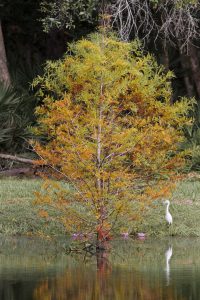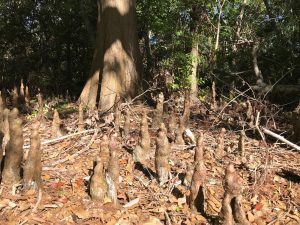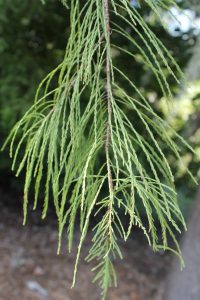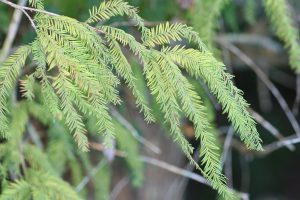Depending who you talk to there are two different species of cypress (Taxodium spp.) trees in Florida, the bald cypress (Taxodium disitichum) and pond cypress (Taxodium ascendens). When I took my dendrology class (the study of forest plants), I learned them as different varieties: Taxodium distichum var. distichum for bald cypress and Taxodium distichum var. imbricarium for pond cypress. It appears they are more commonly accepted as two different species, so let’s see what’s so different about them…
Habitat
Pond cypress gets its common name because it is often found along the edges of lakes and ponds (more stagnant water). Bald cypress are more often found in areas with moving water such as rivers, streams and creeks, but they can also be found in swamps, so habitat isn’t the best way to tell the two apart. Bald cypress gets its name from the fact that it sheds its leaves in the fall giving it a bald appearance, but it should be noted that both species are deciduous…just one reason botanists aren’t a fan of common names and love Latin names. You’ll see why again later.
Size
Pond cypress is a smaller (30-70’) and more narrow than bald cypress, but this is quite difficult to determine when driving by or out in the field. In terms of overall shape (at maturity), pond cypress are said to come to more of a point (think Christmas tree) as compared to a more uniform and rounded look of bald cypress. This results from pond cypress branches which tend to angle upwards toward the top half of the tree whereas bald cypress branches tend to be more horizontal. I haven’t really found this tip (no pun intended) to be helpful, but you never know 😉

Knees
The root “knees” of pond cypress are also said to be more rounded than that of bald cypress, but not an easy characteristic to identify. The debate still remains as to the purpose of these structures and if you want to explore more about that, you can here. This study also suggests a correlation between knee height and water depth. Interesting stuff!

If I left you here, you would probably say this is like all scientific journal articles that end with “more research needed”, but wait, there’s more!
Leaves
This would be the easiest way to tell the two species apart. If the leaves appear needle-like and appressed (leaves pressed to the branches) then you’re looking at a pond cypress. The variety name (imbricarium) means “overlapping” in reference to the manner in which the leaves lie on the twigs. If you’re more in the boat of “two different species” then the specific epithet (second word in the scientific name) still applies with the pond cypress; “ascendens” hints at the leaves that point or grow upward in an arching or curving fashion.

The leaves of bald cypress look more similar in appearance to that of a feather with leaflets branching off to the left and right of the petiole. Again, if you’re in the “two different species” boat then it’s suiting that the specific epithet of bald cypress (distichum) refers to the two (di) ranked leaf.
When leaves are new in the spring they all start off looking like pond cypress leaves, so it’s best to always look at several samples AND to probably wait until new growth has matured. It’s also worthy of noting that the two species will hybridize in the wild, so when all else fails, just say, “It’s a cypress!”

 2
2
